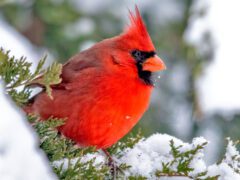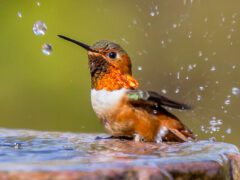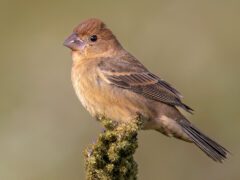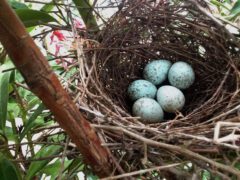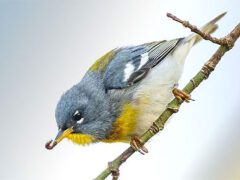Brown Pelican Similar Species Comparison
Main SpeciesBrown Pelican
Breeding adult (Atlantic)
Large and stocky seabird with a long neck and giant bill. Breeding adults have a dark neck and a pale yellow head. Birds from the Atlantic Coast have brown skin on their throat pouch.
© Dan Vickers / Macaulay LibraryFlorida, December 19, 2020Breeding adult (California)
Heavy bodied seabird with a giant bill. During the breeding season their heads have a light golden wash. Breeding adults along the Pacific Coast have red skin on their throat pouch.
© Bryant Olsen / Macaulay LibraryNayarit, February 05, 2016Adults (Atlantic)
Typically forages for schooling fish by diving head-first into shallow waters of coastal estuaries or oceans. Occasionally forages from the water's surface when the water is too murky or shallow for diving.
© Larry Arbanas / Macaulay LibraryFlorida, March 19, 2007Juvenile
Juveniles look similar to adults, but are brown above with a brown neck and grayish bill.
© Jeff Holmes / Macaulay LibraryDelaware, July 30, 2017Juvenile
Does not carry food in its pouch; instead it scoops up fish and releases the water before swallowing them whole.
© Don Danko / Macaulay LibraryFlorida, May 13, 2019Breeding adult with juveniles (Pacific) and Western Gull
Parents begin feed nestlings a few hours after hatching until young are capable of flight at around 11–12 weeks old. After the young leave the nest, parents rarely continue feeding them.
© Jay McGowan / Macaulay LibraryBaja California, March 07, 2014Breeding adult (California)
Graceful flier often seen flying low over the waves, gathering lift as the waves break.
© Grace Oliver / Macaulay LibraryWashington, May 17, 2017Juvenile
Scoops fish out of the water using expandable throat pouch. Before swallowing the fish, they drain the water out of the pouch.
© Darren Clark / Macaulay LibraryGalápagos, September 05, 2014Adults (Atlantic)
Brown Pelicans regularly form large groups year-round. They often preen or loaf on sand bars or open beaches in groups.
© Benjamin Clock / Macaulay LibraryLouisiana, July 13, 2010Nonbreeding adult
Often rests with its head on its shoulder. Nonbreeding birds have a slight yellow wash on their head and a white neck.
© Tim Lenz / Macaulay LibraryCalifornia, November 07, 2009Habitat
Plunges head first into water, scooping up fish with its expandable throat pouch.
© Andrew Newmark / Macaulay LibraryCalifornia, July 25, 2020Adults (Atlantic)
Often flies just above water's surface in small flocks. While in flight, predominant gliding is interspersed with strong, steady wingbeats.
© Larry Arbanas / Macaulay LibraryTexasHabitat
Found year-round in estuaries and coastal marine habitats, often in flocks.
© Mary Harrell / Macaulay LibraryFlorida, June 26, 2017Habitat
Common coastal bird often seen standing on rocks or pilings near shore.
© Tim Lenz / Macaulay LibraryFlorida, December 01, 2013Similar SpeciesAmerican White Pelican
Breeding adult
American White Pelicans are larger than Brown Pelicans. They are bright white with sharply contrasting black wingtips unlike Brown Pelicans.
© Paul Hueber / Macaulay LibraryFlorida, March 31, 2012Similar SpeciesDouble-crested Cormorant
Breeding adult
Double-crested Cormorant are much smaller, darker birds with longer necks and smaller bills than Brown Pelicans.
© Evan Lipton / Macaulay LibraryMassachusetts, July 16, 2016Similar SpeciesBlack-footed Albatross
Adult
Black-footed Albatross are much larger than Brown Pelicans with longer more pointed wings. Their bill, while large, is smaller than the Brown Pelican's bill.
© Brian Sullivan / Macaulay LibraryCalifornia, July 25, 2009Compare with Similar Species
Click on an image to compare
Species in This Family
Pelicans(Order: Pelecaniformes, Family: Pelecanidae)
More to Read
Don't miss a thing! Join our email list
The Cornell Lab will send you updates about birds,
birding, and opportunities to help bird conservation.




